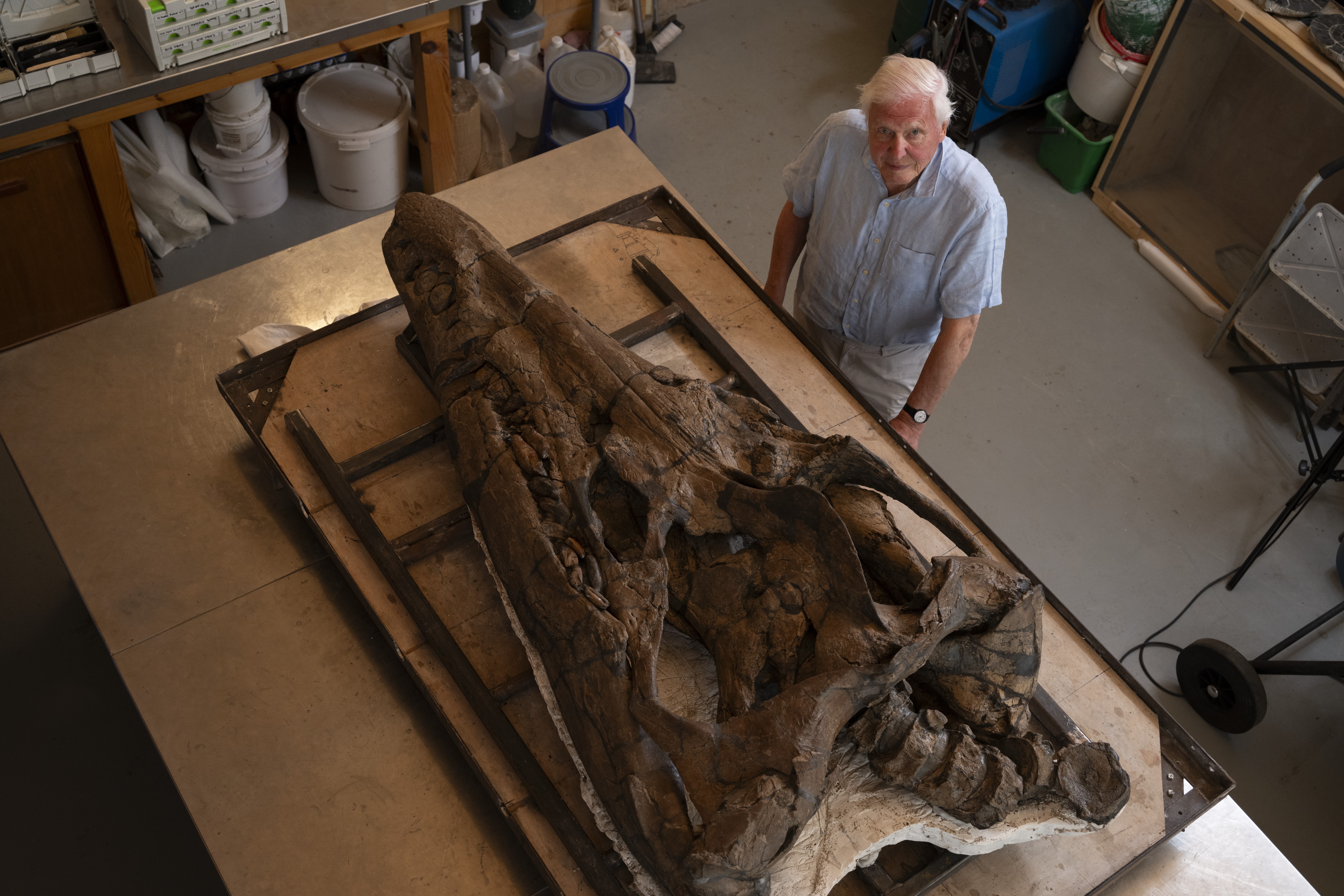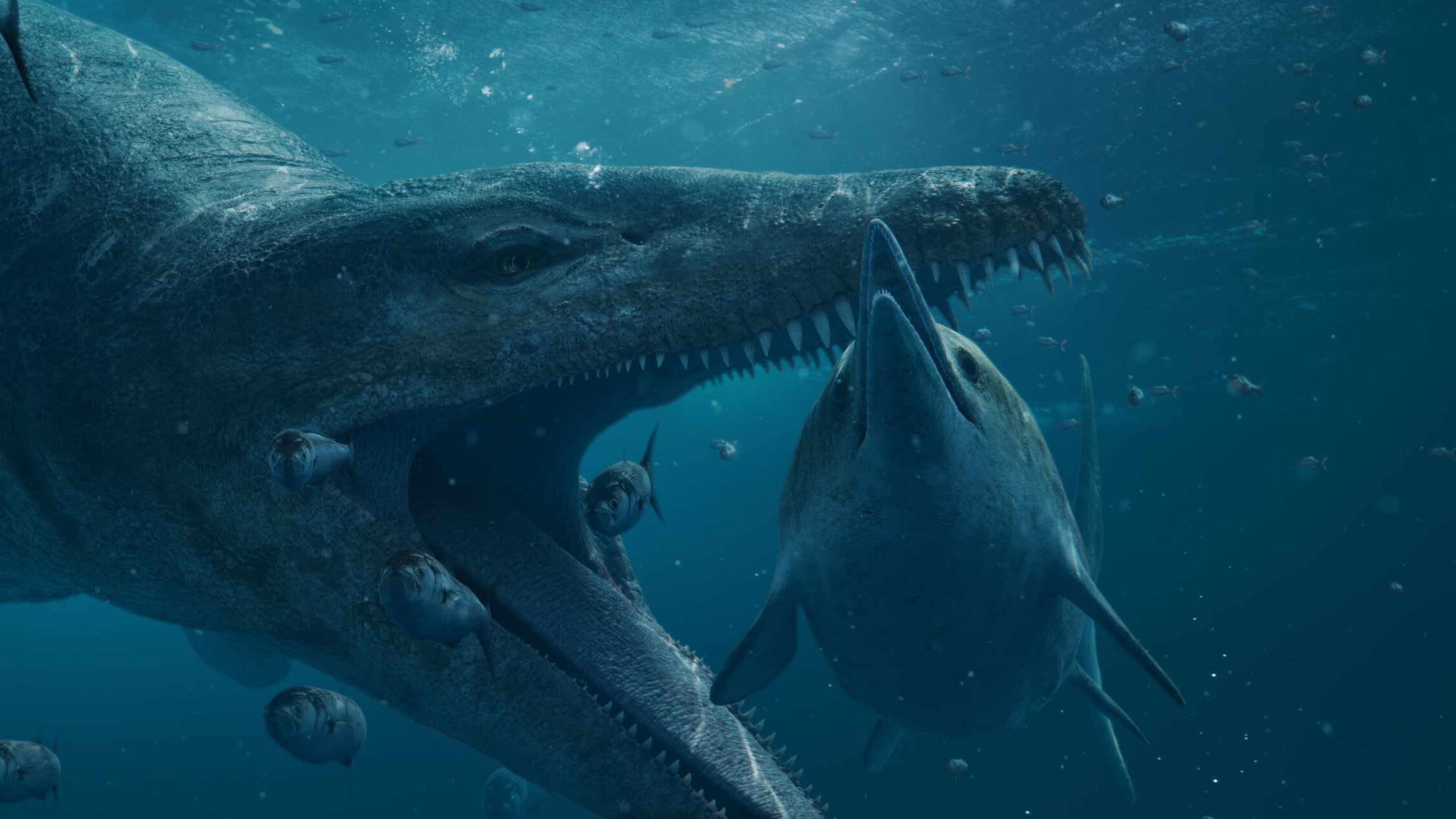Watch 30-foot Jurassic sea monster come back to life in David Attenborough's new pliosaur show
In 2022, fossil hunters noticed a snout sticking out of a cliff face on the Jurassic Coast. It turned out to be one of the largest and most complete pliosaur skulls ever discovered.
Researchers have reconstructed a deadly Jurassic sea monster after excavating an enormous fossilized pliosaur skull from a U.K. cliff face.
The discovery of the skull and subsequent reconstruction are highlighted in a new documentary, "Attenborough and the Jurassic Sea Monster," which airs Wednesday (Feb. 14) on PBS.
The pliosaur — a group of large, carnivorous marine reptiles — and would have been over 30 feet (9 meters) long, with jaws full of huge, razor-sharp teeth. Pliosaurs lived 150 million years ago, when global temperatures were far higher than they are today, with seas that were "warm, shallow and teeming with life," David Attenborough said in a clip from the show. They were the largest ocean predators of the Jurassic period (201.3 million to 145 million years ago).
"The animal would have been so massive that I think it would have been able to prey effectively on anything that was unfortunate enough to be in its space," Andre Rowe, a researcher in the School of Earth Sciences at the University of Bristol in the U.K., told the BBC. "I have no doubt that this was sort of like an underwater T. rex."
Related: Jurassic pliosaur 'megapredator' was a giant 'sea murderer'
In 2022, fossil enthusiast Phil Jacobs was walking along a beach on England's Jurassic Coast when he noticed a bit of snout sticking out of the cliff. He contacted his friend Steve Etches, a paleontologist and prolific fossil collector, and the pair carried the fossil to safety.
But Etches believed more of the pliosaur was locked inside the cliff, so he and his colleagues located and removed the rest of the 6.5-foot (2 m) skull. They took roughly three weeks to excavate the skull from a sheer cliff face while suspended 50 feet (15 m) above the ground.
Sign up for the Live Science daily newsletter now
Get the world’s most fascinating discoveries delivered straight to your inbox.

"It was by far the most difficult, back-breaking and exhausting dig I have ever worked on, both physically and mentally," Etches told Live Science. Eventually, they successfully removed it, and it turned out to be one of the biggest and most complete pliosaur skulls ever found.
Meanwhile, experts at Imperial College London set about reconstructing this Jurassic predator. Researchers knew the sea monsters had short, thick necks and four strong flippers to propel themselves at high speeds, but how these worked together was unclear.
Luke Muscutt, a lab technician at Imperial College London who had been building a robotic plesiosaur — the group of marine reptiles that pliosaurs belong to — as a passion project, built the prototype to show how these extinct reptiles might have moved. "We found that plesiosaurs used a tandem flipper propulsion system, meaning the four flippers work together to push them through water," he said in a statement.

"This system is unique, because all other animals with flippers, like penguins and turtles, only use the front two for propulsion and the back flippers or feet for steering," he said. "We studied this by building a tandem flapping flipper system mounted on a gantry, without a head or tail." Body plates and prosthetic "skin" were then added to the robot to finish the reconstruction.
Scientific research is now being carried out on the pliosaur's skull to learn more about the extinct animal, Etches said. "It gives us a more in-depth look at the individual bones and structures of a pliosaur skull — joints and suture lines, which haven't been previously seen before due to its exceptional preservation," he said.
Etches is also now planning the next phase of excavation in the hope of recovering the rest of the fossilized body. "I stake my life [that] the rest of the animal is there," he told the BBC. This part of the cliff line is going back by feet a year. And it won't be very long before the rest of the pliosaur drops out and gets lost. It's a once in a lifetime opportunity."

Hannah Osborne is the planet Earth and animals editor at Live Science. Prior to Live Science, she worked for several years at Newsweek as the science editor. Before this she was science editor at International Business Times U.K. Hannah holds a master's in journalism from Goldsmith's, University of London.










